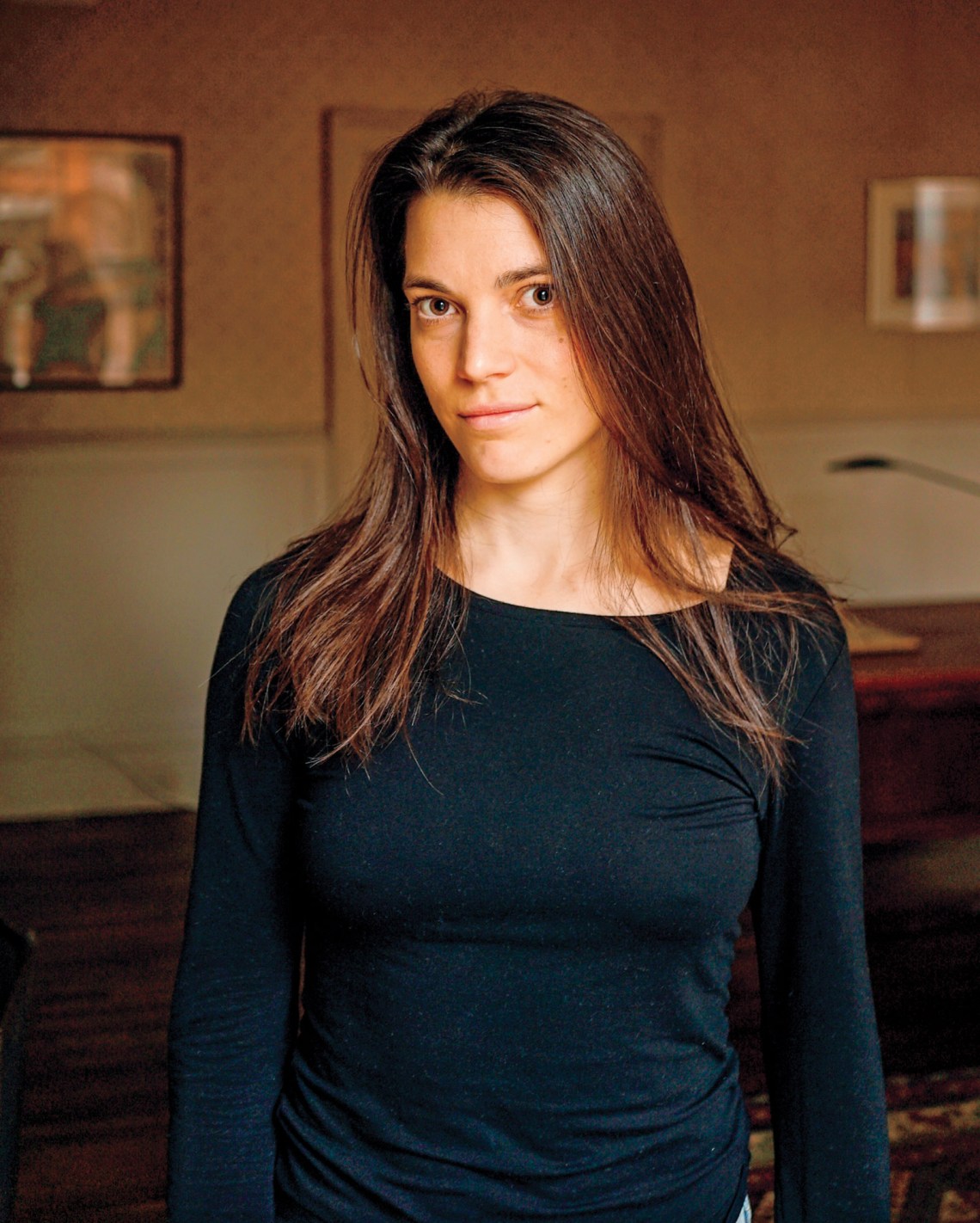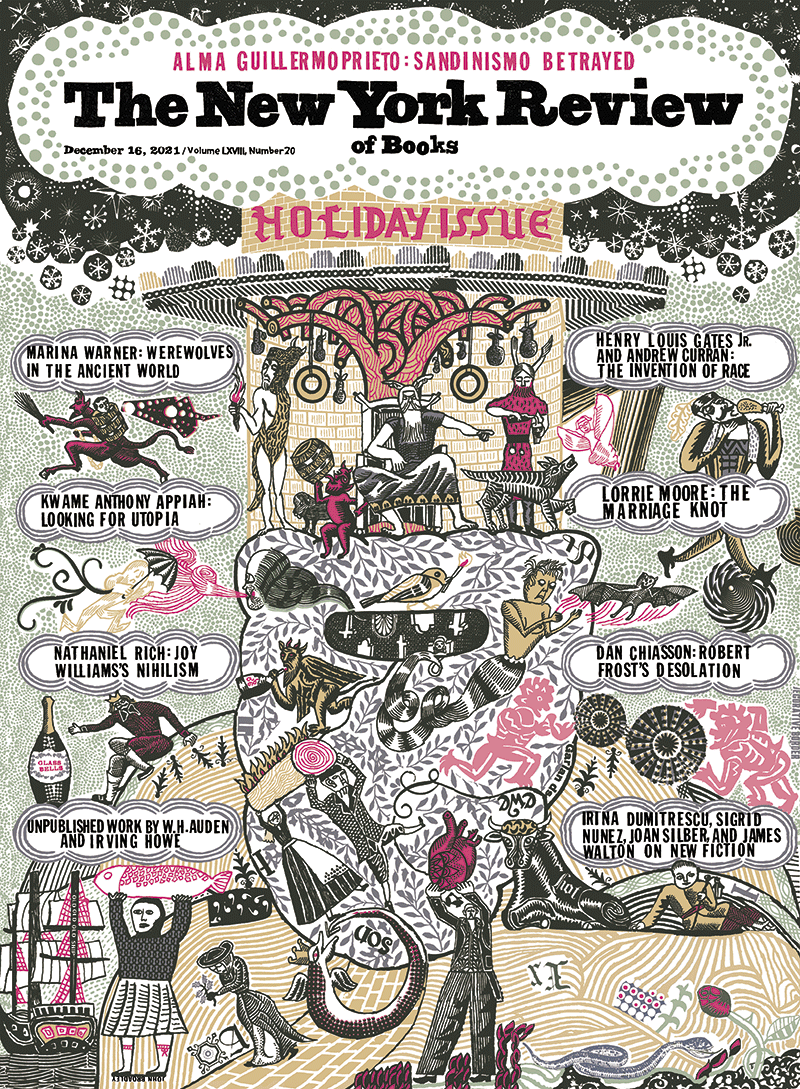Clare Sestanovich’s debut collection of stories, Objects of Desire, begins with Iris, a young woman, flying home from college. “She is seated between a married couple,” we’re told,
because the man prefers the window and the woman prefers the aisle, and they are the kind of people, she discovers quickly, with strong preferences. In general, Iris is the kind of person with mild preferences—preferences that can be painlessly ceded to someone else’s.
While the characters in the eleven stories gathered here have a range of ages and situations, most think of themselves as having “mild” or irresolute wants. Bolder personalities bounce against the less willful ones, often in startling ways—including on the plane ride, when the woman returns from the restroom with a positive pregnancy test stick in her hand and jubilantly passes it across Iris to her husband. “Are you sure you don’t want to sit together?” Iris asks. “Honey,” the woman responds, “you’re part of our moment.”
Iris’s mother, who fetches her at the airport, tells her that it’s too soon for the couple to have told anyone: “That baby…could be gone tomorrow.” Iris thinks of her mother as having “killed” the baby with her words—the mother is a relentless killjoy throughout the story. Back at college, Iris has “a lot of sex. Some of it is good and some of it is bad, and she has taught herself not to care too much about the difference. In general, not caring requires studiousness.” Near the end of her senior year she dates a “virgin” named Ben, and they have sex a single time, so close to graduation day that they say “congratulations” instead of good-bye. He never learns of the later abortion, paid for with a loan from her friend Charlotte’s parents.
We follow Iris in a tale that seems to loosely wander, but whose title, “Annunciation,” is its thematic wreath, half-forgotten en route. While the fearless and glamorous Charlotte goes off to LA, Iris finds a tiny room in the house of a married couple who are in a sexual relationship with another couple nearby. “You probably have a lot of questions,” they keep saying, but she doesn’t—whereas when Charlotte visits, she asks the two couples right away, “So, how did you all meet?” Charlotte proceeds to have sex with the couples and then returns to LA.
Not long after, Iris by chance sees the once-virgin Ben through the window of a restaurant. She has never answered any of his messages, just once texting him Hey nine months after graduation, a date whose meaning he didn’t catch. He beckons her in—it’s a gathering in honor of his grandmother, who just died. His widowed aunt insists on telling Iris about her wedding dress, which her mother hated because it was too bare in the back: “It was my consolation prize.” “Consolation for what?” Iris asks. “Oh, you know,” the aunt says. “The husband, the babies. All that.”
The story closes with the aunt, who has been toying with a sugar packet, blowing the spilled sugar across the tablecloth, scattering it. An image of this sort—lyrical and beautifully mundane, emphasizing the ephemeral—ends many of the stories, giving a degree of formal unity to these known and half-known characters.
Another story, “Terms of Agreement,” follows a trio of young writers—the narrator, her then boyfriend, and their mutual friend Nicole—in the years they first hang out together. The most charismatic of the three is Nicole, who likes having an entourage and becomes lonely and demanding when “in between girlfriends.” The narrator is less confident about her own gifts. Early on she tells us:
When I imagine all the things I’ve written, I imagine them piled up in the kitchen, the mess of an old woman who can’t bear to part with her Tupperware—flimsy plastic in every imaginable size, because someday it might be just the thing she’s looking for. The beginning of a story, the title of an essay.
The narrator meets her boyfriend—the “you” to whom this story is an unsent love letter—through Nicole: “We fell in love and Nicole fell apart.” Though they’re not the cause of Nicole’s breakdown, it soon occupies the couple: “Her crying proved that I had never really cried.” Nicole eventually checks herself into a psychiatric hospital, then slips off with only a call from the airport. When she reappears, she drags the couple to a family wedding and recounts a tale of the first girl she kissed and immediately betrayed. Then in the next scene, there’s the disturbing discovery that Nicole has published a book, full of characters who can be traced to all her friends, with shuffled names. Not badly written either. The narrator and the beloved “you” have already broken up by the time the book comes out. She now thinks, at the story’s end:
Advertisement
I imagine one day I’ll read Nicole’s book again…and I—a person who does not yet exist, a person I have yet to invent—will wonder anew at all that is left unsaid.
Anew. It’s a small form of alchemy. It’s worth waiting for. Like building a building, like finding God, like getting old and stacking Tupperware and wishing for your life, at last, to be contained.
The images that close these stories can have this kind of poetic reach, this upward tilt. If they sometimes feel a little strained, there’s a structural beauty, a hidden order “containing” the wandering episodes. A remarkable talent is at work here.
Sestanovich is an editor at The New Yorker, where two of the stories in this collection—“Old Hope” and “Separation”—first appeared. The latter was accompanied online by an interview in which she said that she began to write the story at a period in her life that seemed “to lack narrative coherence”—people were coming and going “with alarming finality” and there were “no defining features, no unifying theme.” But she knew from “the way people tend to narrativize their lives” that eventually she “would find this ‘phase’ all too easy to sum up: oh, yeah, my twenties.” The various stories in Objects of Desire are, she says, all circling this same notion of narrative coherence, and what happens when it fails to hold, “when we fall apart.”*
So Sestanovich has taken on the challenge of narrating lives cluttered with discontinuities, crowded with incomplete causes and effects, and she’s interested in what characters—who can only know so much—tell themselves about what’s going on. (The reader is left deducing a bit more.) There’s much to admire in the complications of these unplotlike plots, always hopping over the expected.
In “Brenda,” Sestanovich opts for a bit of wry joking about such forms. The title character, who teaches writing at a college and lives alone in a trailer after her boyfriend moves away, thinks her students “fall into three categories”:
There are students with very dramatic lives, which they write about honestly, and poorly…. Then there are students who believe they have dramatic lives, who write at length about small mishaps and deliver the meaning of their stories—the meaning of their lives—in two or three concluding sentences…. Finally, there are students whose greatest fear is that they have no drama at all. They come to Brenda’s office and tell her they have nothing to say—nothing worth saying. They write long, precise paragraphs about objects…. What they avoid most of all is plot.
Brenda likes these students best.
Sestanovich herself writes prose worthy of this belief. Rarely is anything in these stories less than convincing; she is precise about her characters’ often elusive emotions. “Security Questions” begins with a twenty-six-year-old named Georgia googling her lover’s son, a fledgling filmmaker the same age as she is. Georgia, who had a brief spell as an actress and now works for a gourmet meal-kit company, thinks about her lost past:
Georgia and her ex-boyfriend dated for six years. They met during the first week of college and were having sex by Halloween. Georgia had never had sex before, and she was surprised by how effortful it was—like taking a test…. I love you, she said, without having planned to say it. Her boyfriend smiled. When he said it back, some dam opened up inside her. Like being drunk, without the nausea.
The exactness of such passages is elating.
But readerly impatience can sometimes arise. This has to do with which experiences are stressed, which angles we get to view these characters’ lives from. In “Make Believe,” a young woman whose boyfriend has taken off for an unnamed foreign city runs through a series of freelance jobs as a personal assistant to the wealthy or pretend-wealthy and ultimately becomes a night nanny to a five-year-old girl. It’s a job surrounded by odd forms of coldness. “Rehydrate after crying” is care advice from one of the day nannies, and the narrator, less maternal even than the others, can just barely rue her “professional incompetence.” Though it tries not to, the story feels a bit pitiless at this point. The child speaks annoying forms of adult-speak but is still just a kid—both fragile and a little heartless, like just about everyone else in the story.
All the same, there is a good deal to like about the heartlessness that tinges this fiction. The young female characters equipped with it—such as Iris and Brenda, as well as Val in “Wants and Needs”—make a point of avoiding too much focus on their love lives. The pains and longings of romantic love are not absent but are kept slightly offstage. In “Terms of Agreement,” the narrator reflects on a time that has become distant but for its images:
Advertisement
There were many mornings, years ago, when I walked from your house to mine. It was a long walk—there was a bus I might have taken—but I was trying to postpone my arrival, to let the feeling of being with you languish. Back then, this seemed to me like a necessary condition for being in love: to be immune to, or ignorant of, the waste of time. In fact, that was the last time I experienced it, though I have been in love since, as I hope you have, too. On one of those mornings, the sun burned the part in my hair, and for the rest of the day I was consumed by the image of my scalp, white and unknown, streaked with one perfectly straight pink line.
But at times this coolness blots out the better feelings in a story. Here and there I found myself becoming the pesky reader offering secret disapproval. Would it kill you to call him back? I kept asking when Brenda insisted on ignoring her ex-boyfriend’s phone calls. Which is not to say that the stories here don’t include an element of moral horror at the way the world is—but it’s a response the characters hold as spectators (not actors). They’re young—they’re gauging what they feel rather than weighing what they should do about it.
It’s probably worth reiterating that not every story is about the young. In “By Design,” a middle-aged woman with a grown son is thriving in her work until she’s suddenly hit with a suit for sexual harassment. It’s wonderfully well planted, coming as a genuine surprise to the reader, and it’s followed by clever ironies that unfold with shrewdness: the woman keeps hoping she’ll see the man suing her at the lawyer’s office; her ever-out-of-work husband agrees to a divorce without losing his place in a book. In “Separation”—the last in the collection—a woman who meets her first husband while young and skinny-dipping has a long life ahead of her in the story, from early widowhood to a misjudged affair, a second marriage, and motherhood of a troubled teen.
All the same, youth is at the center of this book. And despite its being wasted on the young, youth has the power to send out continually startling news of what’s going on out there, timely reports well beyond the obvious. Americans like to talk about generational voices, though I’m not sure Sestanovich would want to claim such a thing for herself.
At times, the leanness and astuteness in these stories reminded me of Ann Beattie in her early and middle periods, when she was tuned in to the conundrums of her own era (that being the 1970s and 1980s). What’s notable about Beattie’s fiction, especially in collections like Distortions (1976) and Secrets and Surprises (1978), is the rightness of its dialogue and the arch but not too arch ways in which unpredictable intricacies of love and friendship play out their beguilingly weird rearrangements. It’s a white, middle-class world, where sorrow looms rather than catastrophe.
But Sestanovich is more ambitious than that. The challenge for her, in future novels or stories, will be to enlarge her project while retaining her accurate social observation and mastery of particulars. She is already able to delineate in swift detail a narrow world, with its standards and shames and swindles, while indicating that she knows it’s not the whole world. This knowing is what gives the work its weight.
And she has the power to subvert conventional story structure yet build a story with its own order. In “Wants and Needs,” for example, the opening seems to announce an inevitable clash between two people: “The summer Val turned twenty-five, her sort-of stepbrother, Zeke, came to live with her in New York. He was nineteen.” Zeke’s mom was once briefly married to Val’s dad—a marriage no one in Val’s family had heard about until her older brother tried to kill himself and a family therapist was summoned, dredging up secrets.
Zeke is not a bad houseguest, though he does start sleeping with her rich roommate. Val’s own intimacies with Zeke are strongest when she nurses him with real kindness after a sandwich gets him so violently sick she sees desperation in his eyes—“fear that made him look either extremely young or extremely old.” But when Zeke goes off with the roommate to visit her family, Val masturbates to complicated fantasies about being in bed with the two of them while toggling on the computer between romantic kisses on YouTube and “bookmarked porn”: “She finished distractedly…. What kind of person, she thought, fakes an orgasm to herself?”
Though the end-of-summer farewell scene with Zeke brings their sexual tension to the surface, the final sequence takes us back to Val’s “real” brother, older and once suicidal, who has drifted to California, where there are “fires all along the coast that year.” We’d forgotten all about him. It ends with Val obsessively and perversely watching the fires on-screen. Wasn’t this a story about Zeke? Yes and no, as the narrator might say. We’ve been tricked in the best literary way. At the close, we’re in a portrait with a whole other focus.
-
*
See Willing Davidson, “Clare Sestanovich on Narrative Coherence,” newyorker.com, April 5, 2021. ↩




